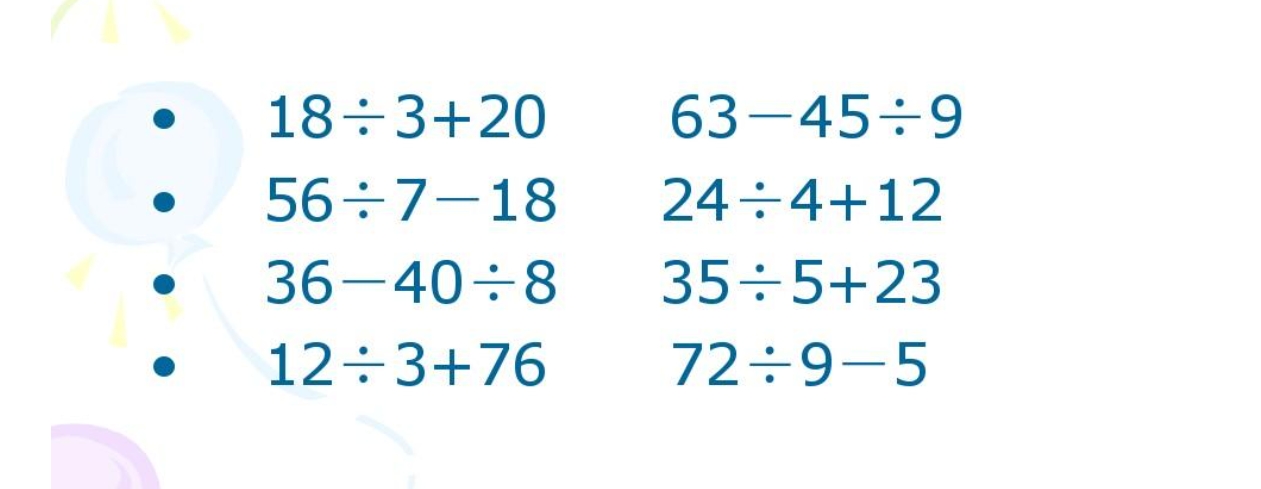Order Of Operations
- What Is the Order of Operations in Math?
- Order of Operations Steps
- Solved Examples On Order Of Operations
- Practice Problems On Order Of Operations
- Frequently Asked Questions On Order Of Operations
Introduction:
In mathematics, the order of operations is a set of rules that establish the sequence in which mathematical operations should be performed in an expression. These rules ensure that there is a universally accepted way to evaluate mathematical expressions so that everyone arrives at the same correct answer. Understanding the order of operations is crucial for correctly solving mathematical problems. This article provides a detailed overview of the order of operations, including its definition, steps, solved examples, practice problems, and frequently asked questions.
Definition:
The order of operations, also known as PEMDAS or BODMAS, is a set of rules used to determine the sequence in which mathematical operations should be performed within an expression. The acronym PEMDAS stands for Parentheses, Exponents, Multiplication and Division (from left to right), and Addition and Subtraction (from left to right). BODMAS is an alternative acronym used in some countries, standing for Brackets, Orders (exponents and roots), Division and Multiplication (from left to right), and Addition and Subtraction (from left to right).

Steps in the Order of Operations:
The order of operations follows a specific sequence for evaluating mathematical expressions. The steps involved in the order of operations are as follows:
Parentheses: Evaluate expressions inside parentheses or brackets first. Start with the innermost parentheses and work outward.
Exponents: Evaluate any exponents or powers next. This involves performing any operations raised to a power or calculating square roots, cube roots, etc.
Multiplication and Division: Perform multiplication and division from left to right. If both operations are present, perform them in the order that they appear.
Addition and Subtraction: Perform addition and subtraction from left to right. If both operations are present, perform them in the order that they appear.
By following these steps, the order of operations ensures that mathematical expressions are solved correctly and consistently.
Solved Examples On Order Of Operations:
Example 1: Evaluate the expression: 4 + 3 * 2.
Solution: According to the order of operations, we must perform the multiplication before the addition. Therefore, we calculate 3 * 2 = 6, and then add 4 + 6 to get the final result of 10.
Example 2: Evaluate the expression: 5 + 2 * (8 - 3).
Solution: Firstly, we simplify the expression inside the parentheses: 8 - 3 = 5. Then, we multiply 2 by the result: 2 * 5 = 10. Finally, we add 5 + 10 to obtain the final result of 15.
Example 3: Evaluate the expression: 9 - 3 + 5 * 2.
Solution: According to the order of operations, we perform the multiplication first: 5 * 2 = 10. Then, we subtract 3 from 9: 9 - 3 = 6. Finally, we add 6 + 10 to get the final result of 16.
Practice Problems On Order Of Operations:
- Evaluate the expression: 7 - 3 * (9 - 2).
- Simplify the expression: 12 + 4 / (8 - 2).
- Evaluate the expression: 5 * (7 + 2) - 6 / 2.
- Simplify the expression: 3 - 2 + 4 * (6 - 3).
Frequently Asked Questions On Order Of Operations:
### Q1. What is the purpose of the order of operations?
A1. The order of operations ensures that mathematical expressions are evaluated in a consistent and agreed-upon manner, allowing for accurate and unambiguous results.
Q2. Can the order of operations be changed?
A2. The order of operations is universally accepted and should not be changed. Altering the order can lead to different results and errors in mathematical calculations.
Q3. Why are parentheses important in the order of operations?
A3. Parentheses indicate that the expressions contained within them should be evaluated first. They allow for grouping and ensure that the operations inside the parentheses are performed before any other operations.
Q4. How do you apply the order of operations to complex expressions?
A4. Complex expressions can be simplified by breaking them down into smaller parts and applying the order of operations step by step. Evaluate expressions within parentheses first, then exponents, followed by multiplication and division, and finally, addition and subtraction.
Q5. Are there any exceptions to the order of operations?
A5. No, there are no exceptions to the order of operations. The rules apply uniformly to all mathematical expressions and must be followed to ensure accurate results.
Conclusion:
The order of operations is a set of rules used to determine the sequence in which mathematical operations should be performed in an expression. Following the order of operations ensures that mathematical calculations are done consistently and accurately. By understanding and applying the order of operations, individuals can solve complex mathematical expressions correctly. This article provided a comprehensive overview of the order of operations, including its definition, steps, solved examples, practice problems, and frequently asked questions. By mastering the order of operations, individuals can enhance their mathematical problem-solving skills and improve their overall mathematical comprehension.